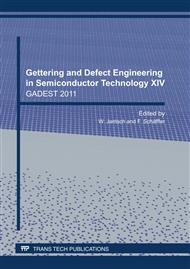p.79
p.88
p.94
p.100
p.106
p.110
p.116
p.125
p.130
Recombination Activity of Twin Boundaries in Silicon Ribbons
Abstract:
Investigations of silicon layers grown on carbon foil were carried out using the Electron Beam Induced Current (EBIC) methods. The most of grain boundaries in these ribbons are (111) twin boundaries elongated along the direction. The EBIC measurements showed that the recombination contrast of dislocations and of the most part of twin boundaries at room temperature is practically absent and only random grain boundaries and very small part of twin boundaries produce a noticeable contrast. At lower temperatures a number of electrically active twin boundaries increases but the most part of them remains inactive. A contamination with iron increases the recombination activity of random boundaries but not the activity of twin boundaries.
Info:
Periodical:
Pages:
106-109
Citation:
Online since:
August 2011
Authors:
Keywords:
Price:
Сopyright:
© 2011 Trans Tech Publications Ltd. All Rights Reserved
Share:
Citation:



